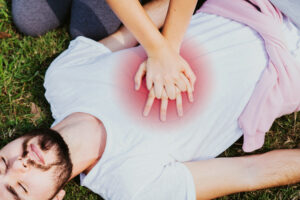 Emergencies can happen anytime, anywhere. When they happen, people often hesitate to involve themselves in the situation in fear and confusion about what to do. However, nobody is exempted from emergencies. How would you deal with it if it occurs and you happen to be around?
Emergencies can happen anytime, anywhere. When they happen, people often hesitate to involve themselves in the situation in fear and confusion about what to do. However, nobody is exempted from emergencies. How would you deal with it if it occurs and you happen to be around?
This article lays down the basics of emergencies, the common emergencies you probably might encounter and how to deal with them.
Know The ABCs Of First Aid
The basic principle of first aid is ABC. When emergencies arise and a person is unresponsive or unconscious, remember ABC:
- Is the person Awake? If not, try waking them up and if they don’t, call 911 and proceed to B. Calling 911 is the best response because it’s always better to be safe than sorry.
- Is the person Breathing? If the person isn’t breathing, provide rescue breathing and chest compressions.
- Continuing Care: Don’t leave the patient and continue treatment until medical help arrives.
It’s crucial to remain calm during emergencies and ensure you don’t jeopardize yourself or another life when attempting to help.
Six Common Medical Emergencies
Now that you know the basics of first aid, here are six common medical situations and how to respond to them accordingly:
- Bleeding
The most common type of medical emergency is bleeding. This situation can be caused by different factors, such as cuts and wounds. Certain body parts bleed a lot, such as the fingers, toes, nose, scalp, and vaginal area. These might produce a lot of bleeding that you can control using first aid treatment:
What to do:
 The rule of thumb is to call 911 or go to the hospital if the emergency scares you. For example, if you are in Idaho and encounter an emergency, like when a tendon is cut, you should proceed directly to an emergency room at Idaho Falls Community Hospital. It may need sutures and a doctor to tend to the wound.
The rule of thumb is to call 911 or go to the hospital if the emergency scares you. For example, if you are in Idaho and encounter an emergency, like when a tendon is cut, you should proceed directly to an emergency room at Idaho Falls Community Hospital. It may need sutures and a doctor to tend to the wound.
Doctors don’t recommend making tourniquets anymore because they cause more damage to the tissues. Instead, you may apply direct pressure on the wound, put a clean piece of cloth around it, and hold it tight until the bleeding stops.
Here are the instances when there’s a large amount of blood loss, and the patient becomes pale, dizzy, and in some cases, loses consciousness. When the following instances happen, you need to seek medical attention:
- The bleeding is uncontrollable even after applying first aid.
- The cut is too deep, and an object is stuck within the wound.
- The tissue or bone is showing.
- Chest Pain
Another common emergency is when someone experiences chest pains. Doctors said that when you see a person grab their chest saying it hurts, the ER world assumes it’s a heart attack until proven otherwise.
What to do:
During chest pains, the best plan of action is to call 911 and perform the ABC. Check the person’s breathing. If they don’t have a pulse, you should start CPR.
When someone isn’t breathing, it’s necessary to position their head with the chin up, open the airway by getting their tongue out of the way, and perform chest compressions.
- Burns
Burns are another typical emergency caused by fire, hot metal, contact with high-tension electric current, friction with a fast-moving object, such as a rope or wheel, and corrosive chemicals such as acids.
In case of burns, make sure to call a medical team early while you provide the following necessary first aid:
- To relieve the pain, you should tend to burns caused by heat with cold water (not a block of ice). Cover it with a clean dressing.
- Burns from contact with electric current cause internal skin damage, so you need to be extra cautious. Turn off the source of electricity to rescue the victim before assessing whether they need CPR.
- In cases of burns due to chemical spillage, remove the chemical using a clean pair of gloves and a cloth. Be careful not to contaminate yourself during the process.
- Choking
There’ll be instances when a person suddenly coughs harder than usual while eating. Coughing does not necessarily mean that they’re choking. It’s an indication that there’s air movement because they’re breathing.
Choking is a serious emergency that can lead to unconsciousness or death due to air blockage in the throat. The following are signs that somebody is choking, and you need to perform the Heimlich maneuver:
- Gasping or gagging
- Inability to make noise
- The face turns red or bluish
- Grabbing the throat
- Arms waving
- Panicking
When you give a Heimlich maneuver, you’re dislodging the food or object in the person’s throat through a series of abdominal thrusts. Be cautious not to do the Heimlich when they’re coughing because it could only worsen things. Avoid hitting them in the back because it might cause the food to return to the windpipe.
- Fainting/Dizziness
There might be occurrences when somebody will approach you and say that they feel weak, dizzy, and ill. It’s a sign to call 911 because that person needs medical attention. Many underlying issues might be causing these symptoms, such as diabetes, heart condition, pregnancy, low blood sugar, or even heart attack.
While waiting for help, you should do the following:
- Check the patient’s level of orientation
- Check their breathing
- Make them comfortable
- Stroke
Lastly, one of the most life-threatening medical emergencies is stroke. It happens when a person’s blood supply or oxygen from the brain is cut, which may be due to a blood clot or bleeding in the brain.
The most vital thing to do when you suspect someone is having a stroke is to call 911. Also, you should remember to look out for signs in this medical situation. Remember the acronym FAST:
- F-ace: Check their face, especially around their eyes and mouth. Has it changed? Can they move their mouth/lips normally? Does it look like their face drooping on one side?
- A-rms: Check if they can lift both their arms. Weakness or numbness in the arms are signs that they have a stroke.
- S-peech: Is there a noticeable change in their speech? Is it slurry? Does it make sense, or are they able to talk at all? Do they respond appropriately when you say something to them?
- T-ime: If you spot any of these symptoms above, dial 911 immediately.
Final Thoughts
Emergencies are inevitable. The best way to medical emergency preparedness is to learn the basics of first aid. In an emergency, providing proper first aid is better than not doing anything at all. With basic knowledge of the ABCs, alertness, and a calm mind, you could just save someone’s life when a medical crisis arises.
